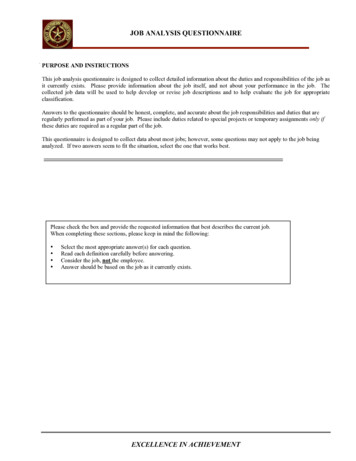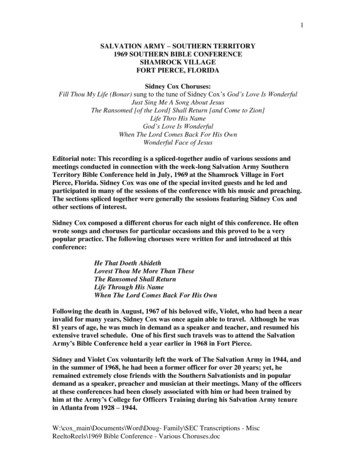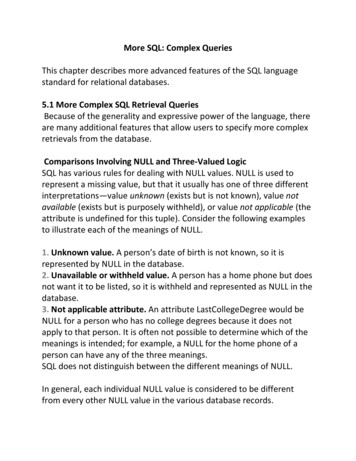
Transcription
JOB ANALYSIS QUESTIONNAIREPURPOSE AND INSTRUCTIONSThis job analysis questionnaire is designed to collect detailed information about the duties and responsibilities of the job asit currently exists. Please provide information about the job itself, and not about your performance in the job. Thecollected job data will be used to help develop or revise job descriptions and to help evaluate the job for appropriateclassification.Answers to the questionnaire should be honest, complete, and accurate about the job responsibilities and duties that areregularly performed as part of your job. Please include duties related to special projects or temporary assignments only ifthese duties are required as a regular part of the job.This questionnaire is designed to collect data about most jobs; however, some questions may not apply to the job beinganalyzed. If two answers seem to fit the situation, select the one that works best.Please check the box and provide the requested information that best describes the current job.When completing these sections, please keep in mind the following: Select the most appropriate answer(s) for each question.Read each definition carefully before answering.Consider the job, not the employee.Answer should be based on the job as it currently exists.EXCELLENCE IN ACHIEVEMENT
JOB ANALYSIS QUESTIONNAIREPlease complete the following, if applicable: Request for Job Evaluation Request for Job Re-EvaluationRequested Job Title: Gift ProcessingSpecialist New PositionRequested Pay Grade: Vacant Occupied PositionPositionA.EMPLOYEE DATA (PLEASE PRINT):Employee Name:Division/College:Telephone: Date:Department:Job Cluster:Job Title:Working Title (if different):Job Code (if applicable):Supervisor's Name:Supervisor's Title:Designee or Division Head/Vice President NameDesignee or Division Head/Vice President TitleFLSA:Employment Type:Pay Grade: Regular Full-time Regular Part-timeEEO Code: Temporary Full-time Temporary Part-timeNumber of hours scheduled to work each week:How long has employee been in the current position: Years MonthsWhat is the employee’s effective hire date with the University:B.PRIMARY PURPOSE OF POSITIONPlease briefly summarize the purpose of your position. (Limit summary to 1 to 2 sentences.)C.DUTIES AND RESPONSIBILITIESForm Revised 12/12/02EXCELLENCE IN ACHIEVEMENTPage 2 of 13
JOB ANALYSIS QUESTIONNAIREDescribe, in order of importance, specific duties and responsibilities and estimate the average percentage oftime spent on each. If possible, use descriptive terms that relate to the objectives or end results of the jobbeing performed. (Example: Prepares charts and diagrams to assist in problem analysis, and submitsrecommendations for solutions).Each statement should be brief and concise, beginning with an action verb. Use a separate statement foreach key task or responsibility.(1) Ensure that a task is not a restatement or overlap of another statement.(2) Review the order of importance and percentage of time.(3) Walk through the process in performing the task and consider the tools & resources used, peopleinvolved, types of decisions, outcomes, etc.(4) Use the Essential Functions Checklist below to determine if specific tasks are considered essentialfunctions as defined under the Americans with Disabilities Act (ADA).MAJOR DUTIES & RESPONSIBILITIESEssentialFunctionList most important duties firstPercentage(%) of timePerforms other job-related duties as required.Form Revised 12/12/02EXCELLENCE IN ACHIEVEMENTPage 3 of 13
JOB ANALYSIS QUESTIONNAIREEssential Functions ChecklistIn determining essential functions, consider first the purpose of the job and the importance of the actual job duties andresponsibilities in achieving this purpose. For the purpose of the Americans with Disabilities Act (ADA), major functionsor duties that are designated as “essential functions” are those fundamental job duties that must be performed with orwithout reasonable accommodation. The term reasonable accommodation'' may include:(A) making existing facilities used by employees readily accessible to and usable by individuals with disabilities; and(B) job restructuring, parttime or modified work schedules, reassignment to a vacant position, acquisition ormodification of equipment or devices, appropriate adjustment or modifications of examinations, training materials orpolicies, the provision of qualified readers or interpreters, and other similar accommodations for individuals withdisabilities.The EEOC Guidelines on the ADA list the following types of evidence to determine whether or not the function inquestion is essential:1.2.3.4.5.6.7.The employer’s judgment as to which functions are essentialWritten job descriptions prepared before advertising or interviewing applicantsThe amount of time spent on the job performing the functionsThe consequences of not requiring the incumbent to perform the functionThe work experience of past incumbents in the jobThe current work experience of incumbents in similar jobsThere are a limited number of other employees available to perform this functionAsk the following questions:The job exists to do this function.Removing this function from the job would fundamentallychange the job.There would be significant consequences if this function isnot performed.Special training or education is required.A license is required.This function is highly specialized.E.EDUCATIONCheck the box which best indicates the minimum formal education requirements. (Not the level of educationthe incumbent has, but the requirements for the job)Minimum Requirements High School Diploma or GED Some College/Associate's Degree Master’s Degree Vocational/Technical/Business School Bachelor's Degree Doctorate DegreeContinuing education required in a field directly related to the incumbent’s duties and responsibilities? Yes or NoIf yes, please describe.Form Revised 12/12/02EXCELLENCE IN ACHIEVEMENTPage 4 of 13
JOB ANALYSIS QUESTIONNAIREE.WORK EXPERIENCELevel and type of experience needed: Please indicate the specific job experience that a new employee should bring to thisposition. For example, "accounting experience in an education environment" vs. " accounting experience". Be sure thatthe experience stated is what is actually required by the job, not what is preferred.Check the box which best fits the minimum length of time spent in performing similar work and acquiring the skills andknowledge to qualify for this position. (Not necessarily the years of the incumbent’s experience, but the job-relatedexperience.) Less than 6 months 1 to 3 years 5 to 7 years 6 months to 1 year 3 to 5 years 7 yearsAfter starting the job, how much on-the-job training does it take to learn the job? Up to 1 month 6 months to 1 yearF. 1 to 3 months 1 to 2 years 3 to 6 months More than 2 yearsTYPE OF SKILL AND/OR LICENSING/CERTIFICATION/REGISTRATIONPlease indicate all specific skills and/or licensing/certification/registration required (not preferred) to do thisjob. For example, spreadsheet software proficiency may be a requirement for a secretarial job; journey licensemay be required for an electrician. None Requires professional licensing, certification or registration, such as registered nursing license,professional engineering license, certified public accountant, and so forth.Software SkillsEx: Word, Excel, Access,HRISCertifications/LicensureEx: Registered NurseOTHER SKILLSForm Revised 12/12/02EXCELLENCE IN ACHIEVEMENTPage 5 of 13
JOB ANALYSIS QUESTIONNAIREG.LEADERSHIP/SUPERVISORY RESPONSIBILITIESWhat is the nature and degree of the direct supervisory responsibility in this job – based on actual duties?Definitions: No supervisory responsibility Work Leadership Supervisor over a section of a department Assistant Manager over supervisors of a smalldepartmentManager of one departmentManager of more than onedepartment Assistant Director Director, through managers, of onedepartmentDirector, throughmanagers, of more than onedepartment Supervises students only.Provides guidance and leadership to employees and/or students for dailyactivities and assigned projects or tasksParticipates in performance evaluation of personnel performance (does notdirectly supervise)May have project management responsibilitiesSupervises employees who generally perform the same work or similarwork/tasksMay occasionally do the work of those supervisedHas HR responsibility for direct reports (confers with manager or director)Provides input for budget preparationProvides first-line management to departmentAllocates resources according to priorities and within budget parametersHas HR responsibilities for direct reportsConsults with Director on operational issues (including fiscal matters)Supervises managers of functional areas.Typically reports to a Director.Directs complex and varied work.Has major budget and expenditure authority.Develops and recommends policy for the department or program.Has major HR responsibilities for staff.Responsible for one or more departments or programs.Typically reports to a senior executive officer (e.g., VP)Typically directs exempt/professional and/or non-exempt employeesDirects more complex and varied workHas full budget responsibilities for respective department(s) or program(s).Recommends and authorizes policy implementation for the department orprogram.Has full HR responsibility for staff direct reportsHow many positions report directly to you?Number of studentsNumber of employeesNumber of employeesHow many positions report indirectly to you?Number of studentsCheck applicable answer(s): Recruits, screens, and interviews candidatesApproves candidates for hireConducts training of othersConducts performance appraisalsRecommends salary actionsRecommends termination of employees Recommends candidates for hireAssigns tasks or responsibilities to othersMonitors work performanceAdministers disciplinary actionApproves salary actionsApproves termination of employeesForm Revised 12/12/02EXCELLENCE IN ACHIEVEMENTPage 6 of 13
JOB ANALYSIS QUESTIONNAIREH.PERSONAL /ORGANIZATIONAL CONTACTSCheck applicable answer: Little or no contact with others. Purpose of contact is to provide and/or receive routine information or documents. Some contact with others, including students, general public, visitors and University personnel. Purpose ofcontacts is to provide explanation or interpretation of information. May handle confidential information and somecomplex matters. Regular and substantial contact with others. Contacts usually involve discussions related to policies and programsand may include proposal or grant writing, negotiation with vendors, solicitation of financial donations for theUniversity, and the like. Handles sensitive, complex, and/or confidential information. Extensive contact with others and usually involve several areas within the University and/or with community,government, business leaders, media and dignitaries. Typically handles highly sensitive and/or confidentialinformation.If as a routine function of this position, list and explain the contacts for this position both inside and outsideTSU. Do not list contacts with supervisors, co-workers, and subordinates.Persons or OrganizationsPurposeHow OftenInside/Outside TSUI.CUSTOMER SERVICE RELATIONSHIPSCheck applicable answer: Requires normal courteous interaction and basic interpersonal skills and tact to communicate with others.Forwards complaints or non-routine inquiries or requests to someone else to handle. Requires moderate interpersonal and communication skills to ensure that customer requests or needs are met.Acknowledges and clarifies customer inquiries, requests, or complaints to ensure that needs are identified,documented and addressed. Assesses and diffuses problem situations and requires influencing others to reach consensus. Requires tact anddiplomacy to handle difficult customer situations. Requires advanced interpersonal and communication skills toestablish and maintain internal and external customer relationships. Explores alternatives and creative solutions tomeeting the needs of the customer. Anticipates customer needs and regularly motivates or influences others to deliver customer service excellence.May troubleshoot highly sensitive or confidential issues. Personally ensures problem resolution. Identifiesbarriers to effective customer service and sets customer service standards. Establishes a customer feedback systemand holds self accountable for customer service excellence within the department.Form Revised 3/10/2009EXCELLENCE IN ACHIEVEMENTPage 7 of 13
JOB ANALYSIS QUESTIONNAIREForm Revised 3/10/2009EXCELLENCE IN ACHIEVEMENTPage 8 of 13
JOB ANALYSIS QUESTIONNAIREJ.ORGANIZATIONAL CHART Please complete the organizational chart below:Title of next level of supervisionTitle of immediate supervisorTitles of other jobs that report to your immediate supervisorIncumbent PositionTitles of jobs that report directly to youK.WORK COMPLEXITY/BUDGET RESPONSIBILITYSelect the description that closely matches the level of variety, difficulty, and magnitude of tasks andresponsibilities: Tasks are highly interrelated and simple. Work consists of fairly standard procedures and tasks. There is no responsibility for budget, revenues and/or expenditures.Tasks are multiple and focus more on single processes. Work is sometimes standardized and sometimesvaried. There is no responsibility for budget, revenues and/or expenditures.Tasks are multiple and diverse with some interrelationship across processes. Work requires the directapplication of a variety of procedures, policies and/or precedents. There is some budget responsibility andexpenditure authority.Tasks and responsibilities require integration of diverse functional areas and involve variables that are moreabstract. Work is substantially complex and varied, and requires the interpretation of technical and d
JOB ANALYSIS QUESTIONNAIRE EXCELLENCE IN ACHIEVEMENT PURPOSE AND INSTRUCTIONS This job analysis questionnaire is designed to collect detailed information about the duties and responsibilities of the job as it currently exists. Please provide information about the job itself, and not about your performance in the job. The










